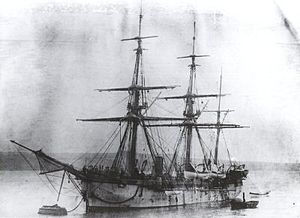 HMS Egeria
| |
| History | |
|---|---|
| Name | HMS Egeria |
| Builder | Pembroke Royal Dockyard |
| Cost | Hull £32,468, machinery £10,414[1] |
| Laid down | 30 December 1872 |
| Launched | 1 November 1873[2] |
| Completed | November 1874 |
| Reclassified | As survey ship, October 1886 |
| Fate | Sold, October 1911 |
| General characteristics | |
| Class and type | Fantome-class sloop |
| Displacement | 949 long tons (964 t) |
| Tons burthen | 727 bm |
| Length | 160 ft (48.8 m) (p/p) |
| Beam | 31 ft 4 in (9.6 m) |
| Draught | 14 ft (4.3 m) |
| Depth | 15 ft 6 in (4.7 m) |
| Installed power | 1,011 ihp (754 kW) |
| Propulsion |
|
| Sail plan | Barque rig |
| Speed | 11 knots (20 km/h; 13 mph) |
| Range | 1,000 nmi (1,900 km; 1,200 mi) at 10 knots (19 km/h; 12 mph) |
| Complement | 125 |
| Armament |
|

HMS Egeria was a 4-gun screw sloop of the Fantome class launched at Pembroke on 1 November 1873. She was named after Egeria, a water nymph of Roman mythology, and was the second ship of the Royal Navy to bear the name. After a busy career in the East Indies, Pacific, Australia and Canada, she was sold for breaking in 1914 and was burnt at Burrard Inlet in British Columbia.
- ^ Cite error: The named reference
RWwas invoked but never defined (see the help page). - ^ "Naval Sloops at battleships-cruisers.co.uk". Retrieved 30 August 2008.